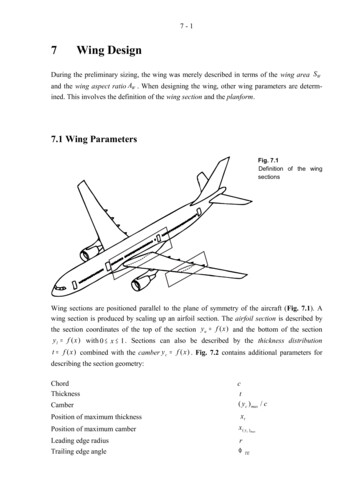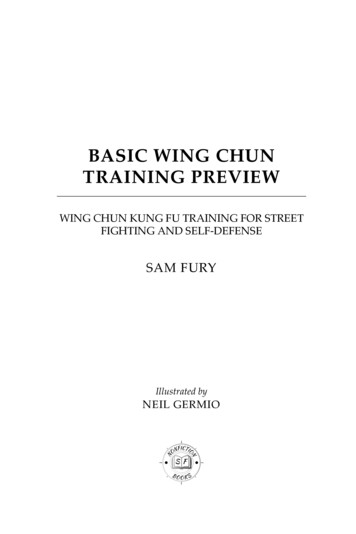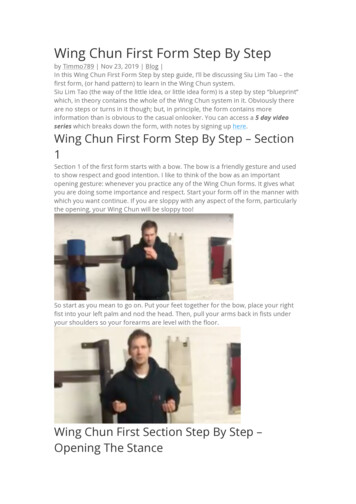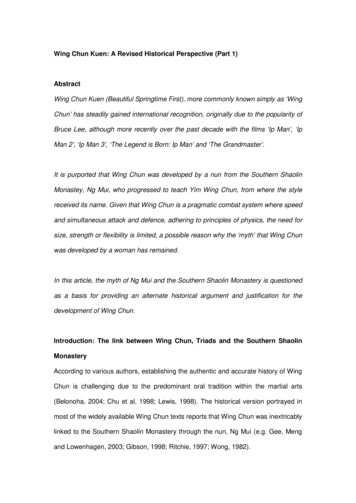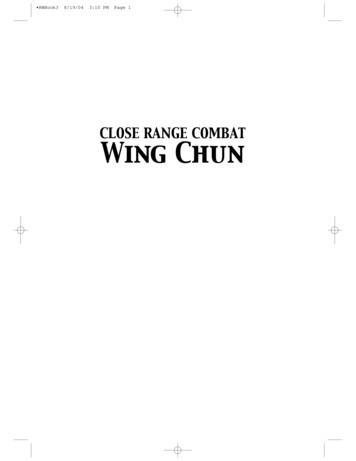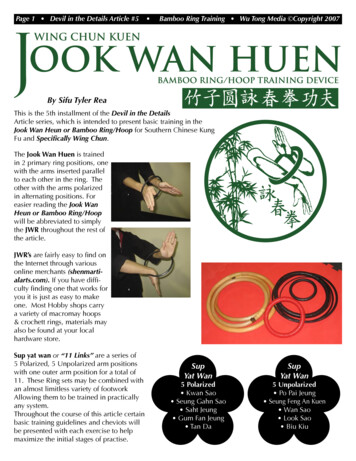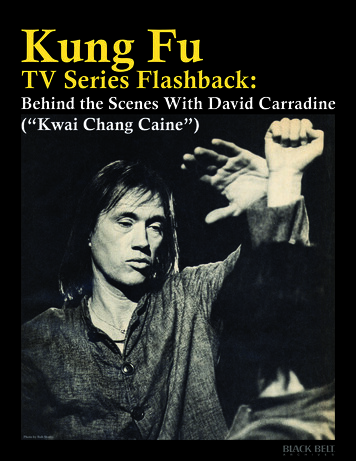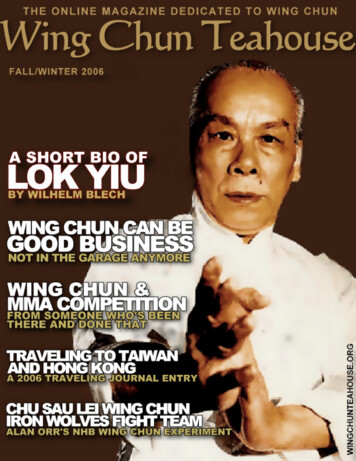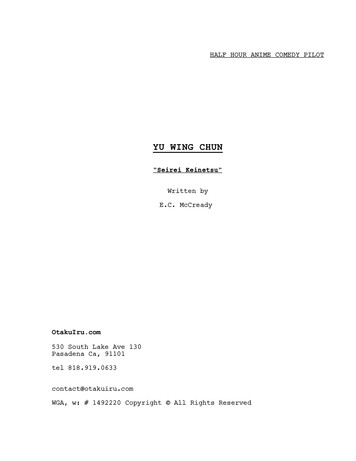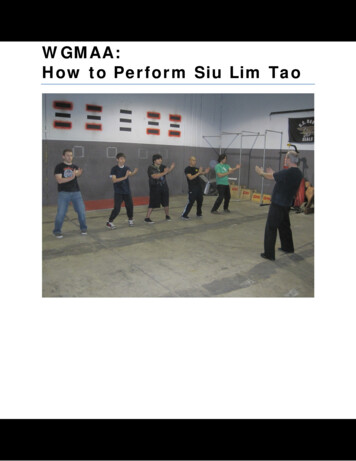
Transcription
In the depths of a London church, oneman is quietly combining faith withmotion to open up the ancient worldof martial arts. Syeda Onjali Bodrulspeaks to Sifu Mckenzie, the newMuslim master of Wing Chun, aboutcarrying forth a timeless legacy.ABDULMALIKAs I make my way down into the basement of a Christian church in Stamford Hill, London, an areaknown for its Orthodox Jewish community, to meeta Muslim Sifu (Kung Fu Master) specialising in the Chineseart of Wing Chun, I am reminded of a saying by philospherMartin Buber – that “all journeys have secret destinations ofwhich the traveller is unaware.” The symbolism of this areawhich seems so effortlessly to entwine different faiths andpeoples for the pursuit of knowledge, is in fact fitting for theexperience I am about to undergo; because over the next fewhours, all preconceptions, all Hollywood-induced notionsand prejudices about this form of combat so intrinsicallylinked to that mystical land of the East, are going to be firmlyput to rest.Contrary to being greeted by a hall full of Karate-Kidstyle robed men giving off high-pitched shrieks as eachimagine themselves to be this decade’s answer to Bruce Lee, I22 emel magazineam instead met by silence. The air is filled withonly one sound: thatof clenched fists slicing through the air, timed tothe rhythm of exhaledbreathing. Before me lies a hall filled with men and women of every colourand creed, dressed in simple black T-shirts bearing the historical insignia ofWing Chun – the Viper and the Crane. And before them stands one figure:Sifu Garry McKenzie, otherwise known as Abdul Malik (Servant of the King) byfellow Muslims, or Ma Ga Lik (Abundance of Power) to those in China, clad in abright yellow T-shirt and white Islamic cap, calmly observing the students thatso strenuously look to him for guidance and approval.Waiting in the sidelines for the class to finish, I find myself mesmerised bythe powerful yet graceful art that is Wing Chun. Mental and physical discipline,precision, balance and flexibility without compromise, all combine to form thiscounter-attack system that has, like an underground secret, journeyed acrosstime and continents to make its way into the scene that stands before me. Basedupon a principle of centreline attacks that target the core of the human body,blocks that redirect an opponent’s strikes, and fighting with a mathematicaldirectness, the appeal of Wing Chun seems to lie in honest simplicity. Fightingphotography Steven Lawson
is not a decorative sport here; it is purely a means to survival.To survive is to succeed, and to succeed, Wing Chun tells uswe must “receive what comes, follow what goes, and strikewhen there is emptiness.” But from where does Wing Chunstem? And how did such a form of combat, usually passedonly from masters to selected disciples as a means of preservation, make its way from ancient China to a church basement in Hackney?The answers lie not only with the Sifu himself, but inthe emblem emblazoned upon each of his students’ T-shirts.Wing Chun, or ‘Ving Tsun’ as it is known, literally means“Eternal Spring”, highlighting the infinity of knowledge andthe capacity to learn which is within the human spirit at alltimes. The legend that surrounds its very creation is as mysterious as it is unique; for unlike most other forms of martialart, the origins of Wing Chun are attributed to two women:first and foremost, Yim Wing Chun (Beautiful EternalSpringtime), and secondly her teacher, a Buddhist nun by thename of Abbess Ng Mui.It is said that whilst fleeing the destruction of her monastery by Qing forces, Abbess Ng Mui, already a formidableexpert in the art of Shaolin kung fu, stopped to observe a fightbetween two creatures: the snake and the crane. Marvelling over the precise and striking moves of the viper and thedance-like fluidity of the winged bird, she gradually began toincorporate them into her own knowledge of kung fu, but itwas not until the Abbess met Yim Wing-Chun that the newform of combat took on a far more forceful stance. Desperateto escape forced marriage to a local warlord, Yim Wing-Chunhad accepted a challenge to fight for her freedom, and soughthelp from the Abbess to perfect her boxing and combat skills.The Abbess conceded to teach her everything she knew, andgradually, the simple theories upon which Wing-Chun arenow based were formed. Yim Wing-Chun went on to winher fight against the warlord, marry the man she loved, andtogether, they passed on their unique fighting techniques tothose they felt would guard its purity.From those first days of its creation, Wing-Chun transcended the tests of time to reach the Great Grand MasterIp Man in 1949: the very same man from whom Bruce Lee24 emel magazine
learnt his most fundamental and now internationally renowned fighting skills. The legacy of Ip Man remains to thisday, for not only has Sifu Mckenzie travelled to Hong Kong tocomplete the Ip Man Ving Tsun training, considered to be themost distinguished level a Sifu can reach, but he did so underthe tutelage of Grand Master Ip Ching, the son of Bruce Lee’sown Ip Man.“That was God’s will,” recalls Sifu Mckenzie. “In 1994I began a Cantonese course that lasted four years and wouldprepare me for making contact with the real Sifus ofHong Kong. During that time, I was lucky enough tobump into the Grand Master Ip Ching at a restaurant in London following a seminar, and althoughhe couldn’t speak English, I was able converse inCantonese. The Grand Master invited me to trainwith him and I accepted, so I’ve been going to HongKong regularly now for the past 12 years.”Wing Chun however, was not GarryMckenzie’s first love. “Like any sixor seven year old, I grew up onKung Fu TV,” he admits witha slight grin. “It appealedto me because I hada particularly hottemper as a child, andenjoyed fighting – infact, I enjoyed fightingso much, my parents sentme and my elder brother off tolearn all about judo. But it just didn’t liveup to what I had seen on TV. I wantedto learn a style of fighting where thestrength of the opponent is not justresisted, but combined with yours, andthen used as a force against that sameopponent. I wanted to learn kicks andstrong techniques, but at that timeChinese martial arts classes had yetto be widely taught. So I movedon to the next best thing: theKorean art of Tae Kwan Do.” By the time Sifu Mckenzie was 15 years old, hebegan entering a variety of competitions but found himself being disqualifieda number of times for using too much force. Then, after an “unfortunateincident”, he realised that something more was needed to suit his own personaland physical needs, so he moved onto amateur boxing.The “unfortunate” incident in question is one that would cause any teento seek a commanding form of self-defence. “After leaving a friend’s house, fiveskinheads began to verbally abuse me,” recalls the Sifu. “I answered back, notunderstanding what their problem was – big mistake. They began chasing me. I ran into a pub for safety but for some reason the landlordkicked me out too, so I was completely exposed to these boys.They broke one of my ribs and caused a fair few other injuries.So from that moment, it was goodbye Tae Kwon Do,and hello boxing.”But the restless nature ofthe Sifu meantthat by the age of 17, even boxing was insufficient for his needs. So onceagain, he turned tothat realm of discovery, thetelevision, for inspiration – and this timehe found exactly whathe was lookingfor. “I joined a WingChun class in 1982 after watching the BBCdocumentary “Way ofthe Warrior”. I was luckyenough to be taught by theteacher who was actuallyused in the programme, anddespite having appeared as thesubject matter for a televisionshow, it somehow seemed unofficially exclusive.” The senseof belonging, of having finallyfound something that met hisphysical demands and yet challenged him on an intellectual level,meant that before long, the soon-tobe Sifuhad reached the top of his class. “Ahierarchy existed within the Wing-Chun class that atfirst seemed unfair. Non-Chinese students seemedto be there only to make up the numbers and usuallyemel magazine 25
lined the last row. Being pushed tothe back, I didn’t get the attention Ideserved, but my attributes and hardtraining allowed me to climb up theladder to become assistant instructor.That was when I began representingthe academy in demonstrations andseminars in the UK and overseas.”When asked what it is about Wing Chun that he finds soappealing, Sifu Mckenzie looks up calmly, and simply states,“It balances you. Between the mental and the physical, is amiddle level, a gap that must be filled. It teaches you to trainand understand yourself – to know what you can do, to realiseyour limitations and push that boundary. Only when you arefully aware of your own capability, can you control and handleany situation. As my Sifu once said, ‘A wise man can act thefool. A fool can never act the wise man’.”Wing Chun for Sifu Mckenzie, cannot be limitedmerely to the physical dimension: it becomes a reflectionof the mind. “Martial arts is more than just a form of selfdefence, it is knowledge too. You are trained not only to fight,but to diffuse a situation by verbal communication and bodylanguage – to frame the entire scenario in the event of anoncoming attack, and most importantly, to never show justhow much you know. Just like the Prophet Muhammaddemonstrated, when it comes to warfare, despite one’s vastknowledge and power, one must appear to be nothing morethan what one is perceived to be.”The Sifu’s alignment of Wing Chunnot only with the general human statebut more fundamentally with his faith,is an intrinsic force which is central to theformation of his character and standingas a teacher. Rarely to be seen without anIslamic cap upon his head, his conversionto Islam seems to have brought with itan underlying humility which is rare to find. “I became a Muslim five yearsago – before that I was a Jehovah’s Witness. They are the only Christian sectthat do not believe in the Trinity, but despite being Unitarian, still believe in ason of God. In a conversation one day with a student of mine I suddenly foundmyself being told that I believed in the very same things the followers of Islambelieved. At that point however, I was still stuck on the notion of Jesus being theson of God: the actual push came much later – in the form of a video by AhmedDeedat. It answered all my questions about the concept of God having a sonand the flaws such a ‘fact’ entailed, so I became a Muslim right there and then.”Despite being a teacher of combat and a master of what some would deem tobe a theory of violence, Islam has it seems, also allowed the Sifu to successfullyreconcile his career with his faith. “The Jehovah’s Witnesses are against anyform of physical combat so it was a continuous struggle to resolve my faith withmy work as a martial artist. However, Islam encourages us to defend ourselves,to condition the body and maintain its fitness.”From the fact that his classes encompass both male and female students ofall ages and backgrounds, including a significant number of Muslim women inhijab, it is clear that the Sifu applies his belief in Islam’s decree of self-defence toeveryone. “If a sister pushing a pram is attacked, should she get on the mobileand call her husband or brother to save her? By the time he reaches her the“Wing Chun teaches you to trainand understand yourself – onlywhen you are fully capable, canyou control and handle anysituation’.”26 emel magazine
ordeal would be over. Learning defence is obligatory in Islamfor both men and women, in the same way as praying is: soteaching self defence is an Islamic duty for me and in turn,influences the way I teach.”Having witnessed the Sifu with his students before theinterview, it is clear that like any great teacher, there is an understanding and mutual respect between master and pupilsthat rarely requires words. There is no shouting, no ‘bullying’tactics, no need for the harsh words I had expected to hearand which inevitably stemmed from my own childhood dietof kung fu movies. In fact, at times, one would be forgivenfor believing the Sifu to be nothing more than an active observer. “Between a good teacher and a good student, theremust always exist a continuing understanding and the willingness to learn from each other. Bruce Lee said ‘Come with
“Between a good teacher and agood student, there must alwaysexist a continuing understandingand the willingness to learn fromeach other.”an empty cup, receive tea, not halffull, not diluted, just pure’, meaning unlearn what you have learnt inthe past. Someone coming to WingChun with an agenda will not work.Learning Wing Chun is a privilege,not a right. Students from othermartial arts have to start with a clean slate and start from thebeginning, just as I had to do when becoming a Muslim. It’sthe only way.”Seventeen years have passed since the day Sifu McKenzie first opened the doors to his own Wing Chun school. Sincethen he has not only watched it branch out across the nationand grow in popularity, but has himself been awarded with aseries of accolades and honours for his ever-strenuous effortsto perfect his schools, and his own abilities. Having been theonly Muslim Sifu to have opened the Ip Man Tong (Hall Museum) and to be featured on Channel 5’s “Combat Club”, Ihave no doubt that the Sifu is a role model, if not a hero, tomany of his own students, both Muslim and non-Muslimalike. So what about him? Who does he aspire to be like? Theanswer is, as I have come to expect from the Sifu, one thatleads back to faith. “Bruce Lee is of course a legacy that end-lessly inspired me as a child, but my trueideal is the Prophet Muhammad: he wasa family man, father, husband, friend,counsellor, statesman and on the battlefield, a lion. But he only fought whenordained to do so by Allah for a just andnoble cause. You cannot beat that.”Watching Sifu Garry Mckenzie/Abdul Malik/Ma Ga Lik walk back to facea new class of eager-eyed pupils, I suddenly realise that like his names, SifuMckenzie is a man who strives to represent for a range of different audiences,a living, breathing link between the ancient world of Wing Chun and newer,younger generations. Be it an English, Muslim, or Chinese pupil, he is open toall without compromising what or who he is. And as I climb up the church stairsand step back into the real world, I feel truly honoured for having witnessed anart form which upholds and teaches the very values upon which Islam is based:the ethos of knowledge and learning from the past, using the mind and bodyfor the procurement of peace and protection, and above all, the courage to bedirect and true to one’s self. Through Sifu Mckenzie, Wing Chun’s history, likethat of Islam, lies not in the decaying enclosure of perishable pages, but withina guarded, sacred and active knowledge being passed down to those deemedcapable of guarding its essence.òwww.thewingchunschool.comemel magazine 29
Wing Chun, or ‘Ving Tsun’ as it is known, literally means “Eternal Spring”, highlighting the infinity of knowledge and the capacity to learn which is within the human spirit at all time
